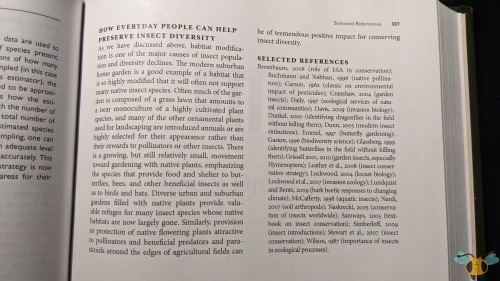#insect textbook
Daly and Doyen’s Introduction to Insect Biology and Diversity 3rd Edition, James Whitfield and Alexander Purcell III
One more little bit of literature to share, and then next week I’ll return to the regular scheduling of sharing insect photos. Yeah, wasn’t really planning for this type of showcase, but it’s worth it to show you (dear reader) what helps me identify insects. This is my textbook from my time at the University of Toronto. Though pricey, it was handy during my time in Insect Biology and was a great asset to getting my bug box ready for the end of the term. Unlike the previous 2 guidebooks, this one is far more technical when it comes to insect identification. This is definitely for the best since identification of tiny organisms requires examination of the tiniest of details. You’d need a dissection microscope to get your money’s worth, more on that later. For now, the knowledge in this book is wonderful. While most of the book is in black and white, colored pictures (like 5 and 6) are used to highlight the fundamentals of the insect world without becoming too technical. It is a textbook after, so you can expected detailed outlines of insects, their systems, their ways of life, habits, locomotion, ecosystem roles and everything in between. The diagrams on Pictures 2-4 are some examples. The insect education is thorough and easy to understand, but when it comes to insect identification, this textbook is extremely thorough. Follow along using Pictures 8 and 9 as examples.
By thoroughly examining a specimen up close and knowing what to look for, an insect can be sorted and classified all the way down the genus, if not the specie if you’re sure. The guide explains exactly what to look for to confirm. You start from the very top of the order and work your way down as your become more familiar with your insect, eventually discovering what it is. The guide outlines what details or structures to focus on, and rules out other insects based on your findings. Now, it’s not completely bulletproof as insects do have variability and there can be wiggle room for interpretation, especially when multiple people are looking at one microscope. One story I have was when I was examining a Bee and trying to determine its family. Since its face was coated in hairs, I couldn’t see the lines on its face. After “shaving” the Bee with an insect pin (not the point), the lines were visible but even with 4+ people looking at the specimen, still no avail. In the end, my professor settled on Andrenidae Bee as the family and wouldn’t mark me down for it. Mining Bees can certainly be a challenge, which is to say nothing of smaller insects. Perhaps we can count that as an anomaly since the organization schema worked perfectly for everything else.
Do I recommend you get this textbook however? Maybe. It’s a little big and technical to bring outside on bug hunts, so the Audubon Guides would do otherwise. If you like insects and would appreciate a comprehensive education tour de force on them, plus technical look at them that doesn’t go into a more research-heavy focus, sure! But it is introductory material (and that can only get you so far). As well, there is a new edition available now (from 2021) so that may be worth checking out instead. For me though, I’m happy with this textbook and am glad to have it as a resource for this blog. Either way, I’d never part with it either as it’s been autographed by one of my most dear friends. You can check out her blog here. She’s just gotten her Doctorate, and I’m so proud of her!
Ally, this post is for you. Thank you!
Post link










